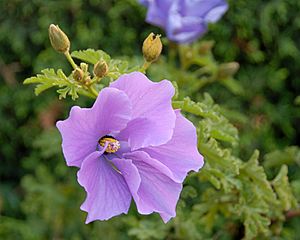Alyogyne huegelii facts for kids
Quick facts for kids Alyogyne huegelii |
|
|---|---|
 |
|
| Scientific classification | |
| Kingdom: | |
| (unranked): | |
| (unranked): | |
| (unranked): | |
| Order: | |
| Family: | |
| Subfamily: |
Malvoideae
|
| Genus: |
Alyogyne
|
| Species: |
A. huegelii
|
| Binomial name | |
| Alyogyne huegelii (Endl.) Fryxell 1968
|
|
Alyogyne huegelii is a beautiful flowering plant. It grows naturally in the southwest part of Western Australia. You can find it all along the coastline. This plant is a large shrub with lovely flowers. It especially likes sandy areas near the coast.
Its big flowers look a lot like those of the Hibiscus plant. Because of this, it used to be called a type of Hibiscus. People often call it the Lilac Hibiscus today. Many people grow it in their gardens because its flowers are so pretty.
Contents
About the Lilac Hibiscus
The Lilac Hibiscus is a shrub that can grow up to four meters tall. It has many branches that grow in different directions. Its bright green leaves are usually divided into three to five parts. The edges of the leaves are uneven, with jagged or toothed shapes. These leaves feel a bit rough and have strong veins.
Each flower grows on a long stem. This stem bends slightly at the point where it joins the leaf.
Its Beautiful Flowers
The flowers have five bright petals. Each petal can be up to 70 mm long. They overlap each other and have slight ridges. The flowers can be cream, purple, or the lilac color that gives the plant its common name.
Inside the flower, there's a tube-like structure with many yellow parts called anthers. These are where the pollen is made. The flower also has five styles that are joined together. Their tips are swollen and look divided. All of this is supported by a five-lobed cup-like structure called a calyx. This calyx is surrounded by up to 10 partly joined leaf-like parts called bracts.
Like other plants in the Malvales group, these flowers usually last only about one day. After they bloom, they become darker and feel like paper. But don't worry, the plant produces many flowers! They bloom for a long time, usually from June to January.
Plant Names and History

This plant was once known as Hibiscus huegelii. It was named after a person called Charles von Hügel. Later, scientists studied the Alyogyne group of plants more closely. They decided that this plant belonged in its own group, the Alyogyne genus.
In 1966, a scientist named Paul Fryxell wrote about this plant. He said it was one of two unique Australian plants in its own genus. In 1968, it was officially moved from Hibiscus to Alyogyne. This means it got its current scientific name, Alyogyne huegelii.
Where it Grows
The Lilac Hibiscus prefers sandy coastal areas. You can find it from Geraldton in the north down to the Esperance Plains in the south of Western Australia. It mostly grows in coastal shrublands and heath areas. It can grow in different types of soil, including sand, limestone, clay, and even granite. Sometimes, it can be found further inland in the Coolgardie region.
Growing Lilac Hibiscus
Many different types of Lilac Hibiscus have been grown by people. They come in colors like white, cream, purple, lilac, and even a color sometimes called blue. People also choose plants with different leaf shapes, like fine or deeply cut leaves. Sometimes, these plants are mixed with other Alyogyne species to create new types.
It's quite easy to grow this plant from cuttings. When you plant it, make sure the soil drains well. It's also important to protect it from frosts. If you want your plant to grow bushier, you can prune it heavily after it finishes flowering.
The Lilac Hibiscus was grown in greenhouses in England a long time ago. Today, people grow it in places with mild weather, like parts of the United States and Europe.


